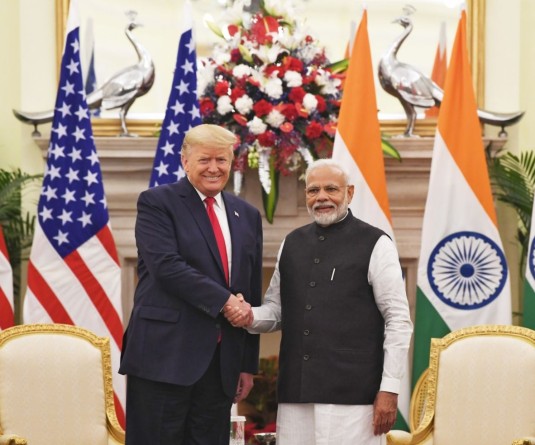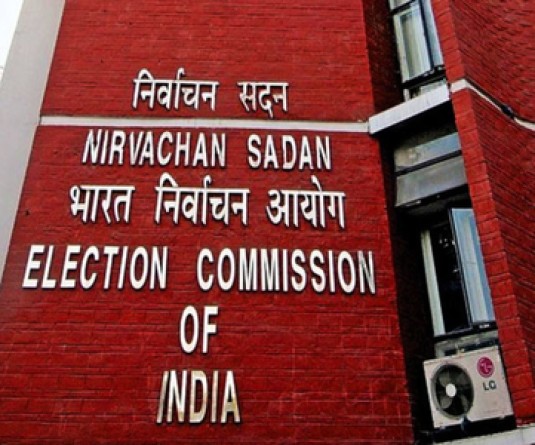Highlights: India unveils budget aimed at boosting incomes, spurring economic growth

The Union Minister for Finance and Corporate Affairs, Nirmala Sitharaman addressing a Post Budget Press Conference, in New Delhi on February 01, 2020. The Minister of State for Finance and Corporate Affairs, Anurag Singh Thakur and the Secretary, Finance & (Financial Services), Rajiv Kumar are also seen. (PIB Photo)
NEW DELHI, February 1 (Reuters) - Finance Minister Nirmala Sitharaman on Saturday unveiled the budget for fiscal 2020-21, vowing to boost income of Indians and their purchasing power, in a bid to revive domestic economic growth that has slumped.
India estimates economic growth this fiscal year, which ends on March 31, will slip to 5% - its weakest pace since the global financial crisis of 2008-09.
These are the highlights from Sitharaman's fiscal 2020-21 budget speech:
GROWTH/DEFICIT
* Nominal GDP growth in 2020/21 estimated at 10%
* Fiscal deficit for 2019/20 seen at 3.8% of GDP
* Fiscal deficit for 2020/21 seen at 3.5% of GDP
* Fiscal deficit for 2021/22 seen at 3.3% of GDP
* Fiscal deficit for 2022/23 seen at 3.1% of GDP
* Revenue deficit seen 2.7% of GDP in FY21
BORROWING
* 2020/21 gross market borrowing seen at 7.8 trillion rupees ($109.75 billion)
* 2020/21 net market borrowing seen at 5.36 trillion rupees ($75.42 billion)
* Government to buy back 300 billion rupees ($4.22 billion) of government bonds in 2020/21
* Government to switch bonds worth 2.7 trillion rupees ($37.99 billion) in FY21
EXPENDITURE
* Revised expenditure 2019/20 26.99 trillion rupees ($379.77 billion)
* Expenditure for 2020/21 estimated at 30.42 trillion rupees ($428.03 billion)
* India defence budget seen at 3.23 trillion rupees ($45.45 billion) in 2020/21
* India to allocate 690 billion rupees ($9.7 billion) toward healthcare spending
* India to allocate 2.83 trillion rupees ($39.82 billion) for agriculture and allied activities
* Approves 3.6 trillion rupees ($50.65 billion) for a federal water scheme
* To allocate 993 billion rupees ($13.97 billion) for the education sector in 2020/21
* To allocate 286 billion rupees ($4.02 billion) on federal schemes for women
SUBSIDY
* Food subsidy seen at 1.15 trillion rupees ($16.18 billion) in 2020/21
* Petroleum subsidy seen at 409.15 billion rupees ($5.76 billion) in 2020/21
* Fertiliser subsidy 713.09 billion rupees ($10.03 billion) in 2020/21
RECEIPTS
* Receipts for 2020/21 estimated at 22.46 trillion rupees ($316.03 billion)
* Aim to get 896.48 billion rupees ($12.61 billion) as dividend from central bank and other financial institutions in 2020/21
DIVESTMENT
* India pegs divestment target for 2020/21 at 2.1 trillion rupees ($29.55 billion)
* Government to sell part of its holding in Life Insurance Corp
TRADE
* Customs duty on walnuts raised to 100% from 30%
* Customs duty on autos and auto parts raised by up to 10%
* Customs duty on platinum and palladium cut to 7.5% from 12.5% for certain purposes
* Nominal health cess of 5% on import of medical devices
TRANSPORT
* India to develop 100 more airports by 2024
* India to monetize over 6,000 km of highways in 12 lots by 2024
* India to privatize at least one major port
POWER/INDUSTRY
* India to provide 273 billion rupees ($3.84 billion) for promotion of industry and commerce
* Firms operating old thermal power plants advised to shut units if emission norms not met
* India to allocate 44 billion rupees ($619.11 million) for clean air incentives in cities with over 1 million people
* India to allocate 220 billion rupees ($3.10 billion) for power and renewables
* Conventional energy meters to be replaced by prepaid smartmeters in the next three years
* India to expand national gas grid to 27,000 km
* Large solar power capacity to be set up alongside rail tracks, on land owned by Indian Railways
* To strengthen anti-dumping regulations
MANUFACTURING
* Scheme focused on encouraging manufacture of mobile phones, electronic equipment and semiconductor packaging to be introduced
* To encourage private sector to build Data Centre Parks throughout the country
* 80 billion rupees ($1.13 billion) over five years to be provided for quantum technologies and applications
* Milk processing capacity to be doubled by 2025
India's growth, fiscal deficit projections challenging to meet - Moody's analyst
MUMBAI (Reuters) - India's nominal growth projection and fiscal deficit target for 2020-21 will be challenging to achieve, a Moody's analyst said on Saturday, after the government presented the union budget to boost economic growth.
India's finance minister, Nirmala Sitharaman, set a fiscal deficit target of 3.5% of GDP for the year ending March 2021 and said it expected nominal GDP of 10%. The government had targeted nominal growth of 12% for the current fiscal year.
"The overall trajectory is not one that's consistent with the fiscal consolidation that we expected earlier," said Gene Fang, associate managing director, sovereign risk group, Moody's Investors Service.
"In addition to that, the 10% nominal growth expectation that's in the 2021 budget is going to be challenging to achieve and as a result that would present some fiscal challenges as well," he said.
Prime Minister Narendra Modi's government said on Saturday it would inject nearly $40 billion into the farm sector and billions more into a federal water scheme to lift economic growth back up from its lowest in a decade.
India's economic growth fell to 4.5% in the July-September quarter - hit by a sharp decline in demand that has stung businesses and forced companies to cut investment and jobs.
On Friday, the government forecast real economic growth will pick up to 6.0% to 6.5% in the fiscal year beginning April 1, but warned that it could mean a high fiscal deficit.
"We are seeing slower trends in terms of real GDP growth. We are projecting real growth to be probably slightly higher than what we've seen in the 2020 year but not significantly so," Fang said.
However, he said the budget announcements did not change the rating agency's stance on India. Moody's rates India at "Baa2" with a "negative" outlook.






